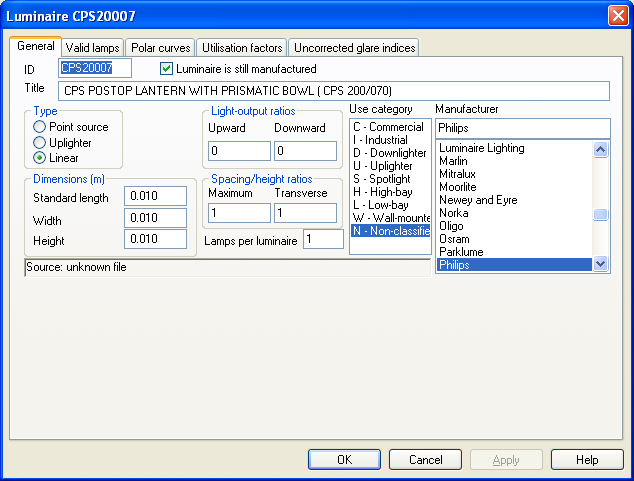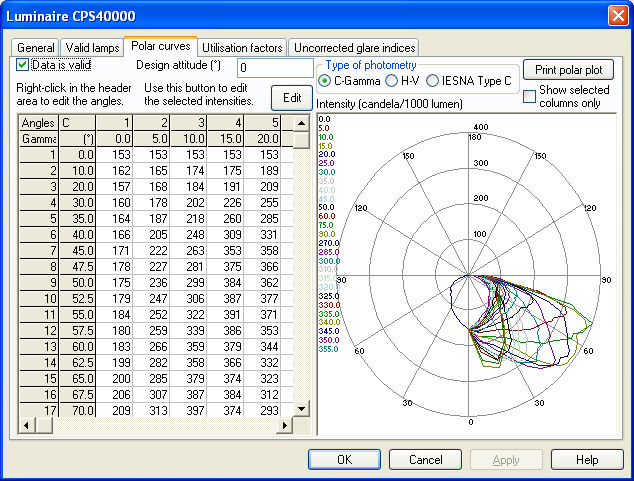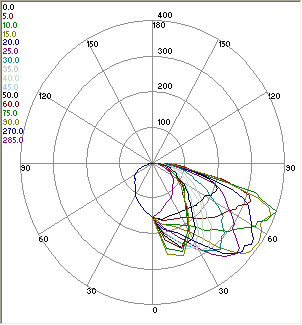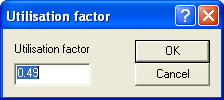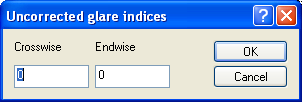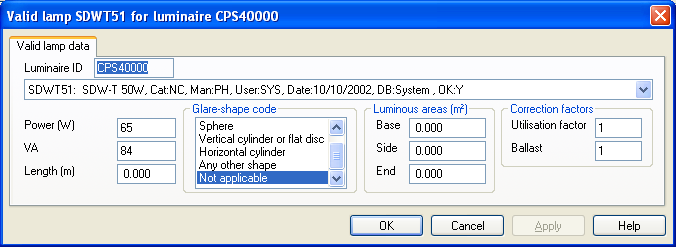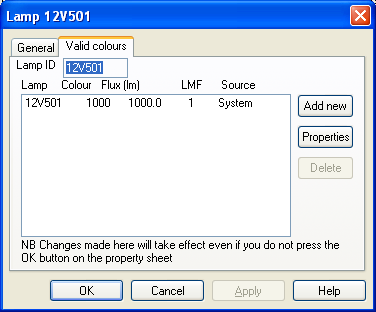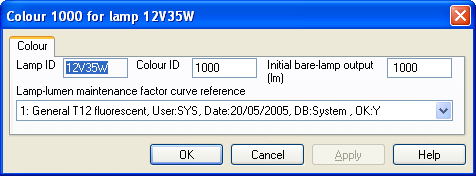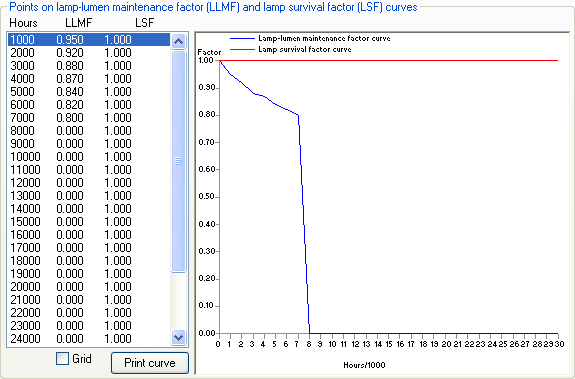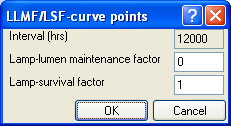Luminaire Property Sheet
This property sheet is for editing the properties of a luminaire. It has five pages:
· General page
· Valid lamps page
· Polar curves page
· Utilisation factors page
· Uncorrected glare indices page
Luminaire General Page
This page allows you to enter the general details required for the luminaire, including its ID and title, type, dimensions, light output ratios and type and manufacturer categories.
Luminaire ID
Enter a unique ID.
Luminaire is Still Manufactured?
Select this box if the item is still manufactured, i.e. still available for use.
Title
Enter a title for this luminaire.
Type Options
Select the type of luminaire:
· Point source option - Select this option to specify that the luminaire may be treated as a point source - i.e. has negligible area of light source.
· Uplighter option - Select this option to specify that the luminaire may be treated as an uplighter - i.e. most of the light output is upwards.
· Linear option - Select this option to specify that the luminaire may be treated as a linear luminaire - i.e. has an extended area of light source.
Standard Length
The luminaire standard length is the length used for photometry. It is the base for glare corrections and has a correction factor for polar curves and a utilisation factor of 1.0 and a glare-indices conversion factor of 0.
Width
The luminaire width is used to calculate the default luminous base area, which is used in the detailed glare calculations.
Height
The luminaire height is used to calculate the default luminaire side and end areas which are used in the detailed glare calculations.
Upward Light Output Ratio
The ratio of the total light output of a luminaire above the horizontal under stated practical conditions to that of the lamp or lamps under reference conditions.
Downward Light Output Ratio
The ratio of the total light output of a luminaire below the horizontal under stated practical conditions to that of the lamp or lamps under reference conditions.
Maximum Spacing/Height Ratio
This ratio describes the distance between luminaire centres in relation to their height above the working plane. The maximum spacing-to-height value should not be exceeded if the uniformity of illuminance is to be acceptable for general lighting.
Transverse Spacing/Height Ratio
The transverse spacing-to-height ratio ensures that spacing in the transverse direction provides the illuminance uniformity.
Lamps per Luminaire
Enter the number of lamps mounted within the luminaire.
Luminaire Use Categories List
Lists the luminaire use categories from which none, one, or more may be selected. The luminaire category is a form of classification, so that particular types of luminaire can be reviewed more easily. See Luminaire use categories for a list of available categories.
Luminaire Manufacturer
Enter a 2-character manufacturer reference if it is not available in the list below.
Luminaire Manufacturers List
The manufacturer name is the second form of luminaire classification so that the review procedure can be used more easily. The manufacturer is represented by a descriptive name. See Luminaire manufacturers for a list of available names, but any other name can be entered in the box above.
Luminaire Valid Lamp Page
This page allows you to edit the list of valid lamps for the luminaire. This is basically a list of entries in the valid lamps table, which contains cross-references to the luminaire and lamps tables, with some additional data. When you add or edit a valid lamp the Valid lamp page appears which allows you to select a lamp from the lamps table. You may also delete any existing valid lamp.
Any number of valid lamps may be specified for each luminaire. For a linear fluorescent fitting for instance you may wish to define the various lengths, such as 1200, 1500 and 1800. Alternatively, a high-bay fitting may be capable of taking a SON lamp or a MBF lamp. For each valid lamp a number of other relevant pieces of data are required, such as the length and wattage, which will depend upon the lamp being used.
Luminaire ID
Shows the luminaire ID. This is not editable here.
List of Valid Lamps
This displays the list of valid lamps for the luminaire.
Add New Button
Adds a new colour for the lamp and displays its property sheet.
Properties Button
Displays the property sheet for the selected colour.
Luminaire Polar Page
This page allows you to edit the polar curve data for the luminaire. The polar curve data is presented in a grid and displayed in the graphic area. Angles may be added, inserted, edited or deleted from the context menu that appears when you click the right mouse button in the shaded area of the grid. The design attitude and photometry type may also be edited. Individual intensity values may be edited by selecting an intensity value and clicking the right mouse button in the non-shaded area of the grid. A range of intensity values may be selected and then edited by pressing the Edit button.
Polar-curve data may be measured using the “C-gamma” (C-γ) system, the “Horizontal–Vertical” (H-V) system or the “IESNA Type C” system (see CIBSE Technical Memorandum 14 and IESNA-LM63 for further information on these systems).
The C-gamma system allows both point and linear sources to be defined in the same manner.
A maximum of 72 C (or H) angles and 55 gamma (or V) angles can be defined when the data is entered interactively. For example, for a symmetrical luminaire this allows the C angles to be in steps of 15 degrees from 0 to 180, and the gamma angles to be in steps of 5 degrees from 0 to 180. Such a large number of polar points will allow almost any type of polar curve to be defined, yet not all values need to be entered when specifying simple symmetrical polar curves. You can define the actual angles; in this way a large number of points can be specified where the curve is rapidly changing and fewer where the curve is changing little. The luminous intensities should all be expressed in terms of candelas per thousand lumens. Note that if the data are entered from a standard format file using the database facility, 72 C angles and 55 gamma angles can be defined.
Data is Valid?
Select this box if the polar data is valid for use in calculations.
Design Attitude
The design attitude is the angle at which the luminaire is designed to operate. For normal indoor luminaires it is zero.
Edit button
If a range of intensities are selected this button will allow you to enter a new value to apply to the whole range. So, for instance, you may select the whole row at gamma=0 and set them to the same value in one go.
Photometry Options
Select the photometry that was used to create this data:
· C-gamma option - Most interior luminaires are photometered using the C-gamma system.
· Horizontal-vertical option - Floodlights (due to their intensity distribution) are usually photometered using the horizontal-vertical system.
· IESNA Type C option – similar to H-V but differing in the pole direction.
Show Selected Column Only Check Box
This check box allows you to turn on or off the display of the selected column (i.e. one C (or Horizontal) angle) of polar intensity values. This is useful if you have defined several C (or Horizontal) angles and want to see the data for individual angles.
Polar Data Grid
Displays the numeric values of the polar data. C (or Horizontal) angles are listed along rows 1 and 2. Gamma (or Vertical) angles are listed down columns 1 and 2. The body of the grid shows the intensities for the relevant pair of angles (in candelas/1000 lumen). The right mouse button may be clicked in any of these three areas to edit the angles or intensity values.
Angles Menu
This menu is available when you right-click in grid row 1 or column 1, and it allows you to select an option for editing angles for the polar curve:
· Edit angle - Select this option to edit the selected angle.
· Insert angle - Select this option to insert a new angle at the currently selected position in the list.
· Add angle - Select this option to add a new angle at the end of the list.
· Remove angle - Select this option to remove the selected angle from the list.
· Visualise – use a window like the Model Viewer to see the photometric web generated by the polar curves.
Polar Curve Display
Displays the polar curves graphically, for confirmation. If the Show selected column only check box is selected, it displays only the column that has the currently selected grid cell:
Double-clicking on this plot has the same effect as using the Angles > Visualise menu option.
Luminaire Utilisation Factor Page
Allows you to edit the list of utilisation factors at standard room indices for the luminaire. Individual values may be edited using the
Utilisation factor dialogue box . Note it is recommended that you use the database calculations to calculate these values rather than entering them manually here. The utilisation factor is the proportion of luminous flux emitted by the lamps that reaches the working plane. The factors should be for zero reflectances for the nominal spacing-to-height ratio at the standard room indices, as described in CIBSE TM5. Nine values should be entered in ascending order, to correspond to room indices of 0.75, 1.0, 1.25, 1.5, 2.0, 2.5, 3.0, 4.0, and 5.0.
Data is Valid?
Select this box if the UF data is valid for use in calculations.
Utilisation Factor List
Displays the list of utilisation factors for the different room indices. Double-click a row to edit it, or select a row and press the Edit button.
Edit Button
Edits the selected row.
Utilisation Factor Dialogue Box
Allows you to edit an individual utilisation factor for the luminaire.
Uncorrected Glare Indices Page
This page allows you to edit the uncorrected crosswise and endwise glare indices at the standard room reflectances. Individual rows may be edited using the
Glare dialogue box . Note it is recommended that you use the database calculations to calculate these values rather than entering them manually here. The indices should be entered for each of the nineteen standard-room dimensions, as described in CIBSE TM10. They should be for ceiling, wall and floor reflectances of 70%, 50% and 20% respectively.
Data is Valid?
Select this box if the glare data is valid for use in calculations.
Glare Data List
Lists the glare indices for each set of standard room dimensions. Double-click a row to edit it, or select a row and press the Edit button.
Edit Button
Edits the selected row.
Glare Dialogue Box
Allows you to edit an individual pair of uncorrected crosswise and endwise glare indices for the luminaire.
· Crosswise glare - allows you to edit the crosswise glare index.
· Endwise glare - allows you to edit the endwise glare index.
Valid Lamp Property Sheet
This property sheet is for editing the properties of a lamp-luminaire relationship (referred to as a valid lamp for a luminaire). It has only one page:
Valid Lamp Page
This page gives the details of one valid lamp for a luminaire. It allows you to select the lamp from the list of lamps in the database, and to enter the additional data required for each luminaire-lamp cross-reference.
Luminaire ID
Shows the luminaire ID. This is not editable here.
Lamps List
Shows the complete list of lamps in the database, from which you must select one to use with this luminaire.
Watts
The luminaire wattage is the TOTAL power consumed by the lamps AND control gear and is used by the program to calculate the total wattage for a particular lighting scheme.
VA
The luminaire voltamperes are the apparent power consumed by the luminaire. It is the product of the total current input to the luminaire and the supply voltage.
Lamp Length
Enter the lamp length in metres.
Shape Codes List
Allows you to select from the list of standard shape codes. Select one of the following glare-shape codes (as defined in the CIBSE Technical Memorandum Number 14):
· Rectangular box
· Sphere
· Vertical cylinder or flat disc
· Horizontal cylinder
· Any other shape
· Not applicable
Base Area
The luminous areas are used by the program when calculating glare indices from basic principles. The default base area is the product of the luminaire width and length for this lamp.
Side Area
The luminous areas are used by the program when calculating glare indices from basic principles. The default side area is the product of the luminaire height and length for this lamp.
End Area
The luminous areas are used by the program when calculating glare indices from basic principles. The default end area is the product of the luminaire width and height for this lamp.
Utilisation Factor Correction Factor
The utilisation-factor correction factor is used to convert the UF data when the standard is not being used. It is also applied to the polar - curve data.
Ballast Correction Factor
The ballast-correction factor is the ratio of the light output of a reference lamp operated under reference conditions on a test ballast to the light output of the same lamp operated under the same conditions on a reference ballast.
Lamp Property Sheet
This property sheet is for editing the properties of a lamp. It has two pages:
Lamp General Page
This page allows you to set the lamp ID and title, whether it is still manufactured, select a type category, and select or enter a manufacturer.
Lamp ID
Enter a unique ID.
Lamp is Still Manufactured?
Select this box if the lamp data is valid, i.e. it is still manufactured.
Title
Enter a title for this lamp.
Lamp Type Categories List
Lists the lamp-type categories from which one may be selected. The lamp-type category is a form of classification, so that particular types of lamp can be reviewed more easily. See Lamp type categories for a list of available categories.
Lamp Manufacturer
Enter a manufacturer’s name if it is not available in the list below.
Lamp Manufacturers List
Displays a list of lamp manufacturers from which one may be selected. The lamp-manufacturer is represented by a descriptive name. See Lamp manufacturers for a list of available names. However you may enter ANY other manufacturer name in the box above.
Lamp Colours Page
This page allows you to edit the list of valid colours for the lamp. This is basically a list of entries in the colours table (not to a separate cross-reference table as used for valid lamps). When you add or edit a valid colour the Colour property sheet appears which allows you add a colour to the database. You may also delete any existing valid colour.
Lamp ID
Shows the lamp ID. This is not editable here.
Colours List
Lists the available colours for the selected lamp. Double-click or select and press Properties to edit.
Add New Button
Adds a new colour for the lamp and displays its property sheet.
Properties Button
Displays the property sheet for the selected colour.
Delete Button
Deletes the selected colour.
Colour Property Sheet
This property sheet is for editing the properties of an available colour that has been assigned to a lamp. It has only one page:
Colour Page
This page allows you to edit a valid lamp colour. You may change its ID, its initial bare lamp output, and its cross-reference to the LLMF/LSF curves table.
Lamp ID
Shows the lamp ID. This is not editable here.
Colour ID
Enter a unique ID.
Initial Bare-lamp Output
The initial bare-lamp output is the luminous flux measured after 100 hours and is used in the calculations to determine the total luminous flux within the room.
Lamp-lumen Maintenance Factor Curve List
Shows the complete list of LLMF/LSF curve sets in the database, from which you must select one to use with this lamp.
Lamp-lumen Maintenance Factor Curve Property Sheet
This property sheet is for editing the properties of a pair of time-depreciation curves for lamp-lumen maintenance factor and for lamp survival factor. It has only one page:
Lamp-lumen Maintenance Factor Curve Page
This page allows you to specify the curves used when looking up the lamp-lumen maintenance factor and lamp survival factor based on the lamp replacement period. Each curve is given a numeric reference and a title that will be displayed in the selection lists. The curve is displayed in the graphic area for confirmation, and a grid may be overlaid if you wish.
The percentage lamp-lumen maintenance factors and lamp survival factors for time intervals of 1000 hours should be entered. Individual rows may be edited by double-clicking the row; this displays the LLMF/LSF dialogue box where the values may be edited.
Reference
The lamp-lumen maintenance-factor (LLMF) curve reference is a code used to identify a LLMF/LSF curve set. System curves have a code in the range of 1 - 99 and user curves have a code in the range 100 - 9999.
Title
This allows you to specify a title for the LLMF/LSF curve set.
List of Curve Points
This displays the list of points on the LLMF and LSF curves. The first column shows the time interval, the second column the LLMF value, and the third column the LSF value.
Grid Check Box
Turns on or off the display of the grid on the graph of the LLMF and LSF curves:
Print Curve Button
Allows you to print the contents of the dialogue box.
Curve Display
Displays the LLMF and LSF curves graphically, for confirmation.
LLMF/LSF Dialogue Box
Allows you to edit an individual pair of points in the LLMF and LSF curves for the luminaire.
Interval - this displays the interval in hours of the selected curve points.
Lamp-lumen maintenance factor - allows you to enter the lamp lumen maintenance factor at this time interval. This represents an average deterioration in lamp luminous output due to dust build-up etc.
Lamp survival factor - allows you to enter the lamp survival factor at this time interval. This category is used to assess the proportion of lamps that have not failed after a set time. Typical lamp survival factors are shown in the CIBSE Code for Interior Lighting, 1994, Table 4.4.
